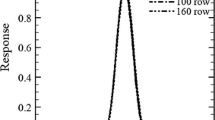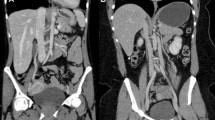Abstract
The purpose of this paper is to compare the influence of detector collimation on the signal-to-noise ratio (SNR) for a 5.0 mm reconstructed slice thickness for four multi-detector row CT (MDCT) units. SNRs were measured on Catphan test phantom images from four MDCT units: a GE LightSpeed QX/I, a Marconi MX 8000, a Toshiba Aquilion and a Siemens Volume Zoom. Five-millimetre-thick reconstructed slices were obtained from acquisitions performed using detector collimations of 2.0–2.5 mm and 5.0 mm, 120 kV, a 360° tube rotation time of 0.5 s, a wide range of mA and pitch values in the range of 0.75–0.85 and 1.25–1.5. For each set of acquisition parameters, a Wiener spectrum was also calculated. Statistical differences in SNR for the different acquisition parameters were evaluated using a Student’s t-test (P<0.05). The influence of detector collimation on the SNR for a 5.0-mm reconstructed slice thickness is different for different MDCT scanners. At pitch values lower than unity, the use of a small detector collimation to produce 5.0-mm thick slices is beneficial for one unit and detrimental for another. At pitch values higher than unity, using a small detector collimation is beneficial for two units. One manufacturer uses different reconstruction filters when switching from a 2.5- to a 5.0-mm detector collimation. For a comparable reconstructed slice thickness, using a smaller detector collimation does not always reduce image noise. Thus, the impact of the detector collimation on image noise should be determined by standard deviation calculations, and also by assessing the power spectra of the noise.



Similar content being viewed by others
References
Kalender WA, Seissler W, Klotz E, Vock P (1990) Spiral volumetric CT with single-breath-hold technique, continuous transport, and continuous scanner rotation. Radiology 176:181–183
Liang Y, Kruger RA (1996) Dual-slice spiral versus single-slice spiral scanning: comparison of the physical performance of two computed tomography scanners. Med Phys 23:205–220
Hu H, He HD, Foley WD, Fox SH (2000) Four multidetector-row helical CT: image quality and volume coverage speed. Radiology 215:55–62
McCollough CH, Zink FE (1999) Performance evaluation of a multi-slice CT system. Med Phys 26:2223–2230
Hu H, Fox SH (1996) The effect of helical pitch and beam collimation on the lesion contrast and slice profile in helical CT imaging. Med Phys 23:1943–1954
Brooks RA, Di Chiro G (1976) Statistical limitations in X-ray reconstructive tomography. Med Phys 3:237–240
Kalender WA, Schmidt B (2000) Recent advances in CT: will doses go down or will they go up? Physica Medica 16:137–144
Hu H, Shen Y (1998) Helical CT reconstruction with longitudinal filtration. Med Phys 25:2130–2138
Hu H (1999) Multi-slice helical CT: scan and reconstruction. Med Phys 26:5–18
Shin HO, Falck CV, Galanski M (2004) Low-contrast detectability in volume rendering: a phantom study on multidetector-row spiral CT data. Eur Radiol 14(2):341–349
International Electrotechnical Committee (1994) Medical diagnostic X-ray equipment—radiation conditions for use in the determination of characteristics. Standard IEC #61267, Geneva
International Electrotechnical Committee (1999) Medical diagnostic X-ray equipment—particular requirements for the safety of X-ray equipment for CT 1999. Standard IEC #60601-2-44, Geneva
International Electrotechnical Committee (2002) Medical diagnostic X-ray equipment—particular requirements for the safety of X-ray equipment for CT. Standard IEC #60601-2-44, Geneva
Dainty JC, Shaw R (1974) Image science. Academic, London
Greess H, Lutze J, Nomayr A, Wolf H, Hothorn T, Kalender WA, Bautz W (2004) Dose reduction in subsecond multislice CT examination of children by online tube current modulation. Eur Radiol 14(6):995–999
Acknowledgements
The authors acknowledge Dr J.-L Dreyer (Neuchâtel, Switzerland), Drs A. Blum and T. Ludig (Nancy, France) and Dr F. Sadry (Givisier, Switzerland) for providing the machine time required to perform the study.
Author information
Authors and Affiliations
Corresponding author
Rights and permissions
About this article
Cite this article
Verdun, F.R., Noel, A., Meuli, R. et al. Influence of detector collimation on SNR in four different MDCT scanners using a reconstructed slice thickness of 5 mm. Eur Radiol 14, 1866–1872 (2004). https://doi.org/10.1007/s00330-004-2420-3
Received:
Revised:
Accepted:
Published:
Issue Date:
DOI: https://doi.org/10.1007/s00330-004-2420-3




